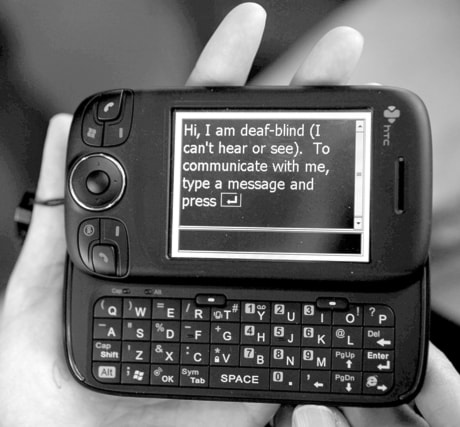Not long ago, Robert J. Steppler walked from his home to a little coffee shop nearby, ordered a green tea and chatted with the baristas.
While that may sound hardly worthy of note, for Steppler and others like him, it most certainly is.
Steppler, a deaf-blind individual, is one of the first people in the world to use a new device called the DeafBlind Communicator, which allows him to communicate freely despite his disabilities.
The two-piece portable device was conceived by Washington state’s Office of the Deaf and Hard of Hearing, built by the Canadian company HumanWare and perfected with feedback from the members of Seattle’s deaf-blind community.
“It’s so cool to see people smile spontaneously, joyously when they use it for the first time and realize the possibilities,” said Deborah Schow, a spokeswoman for the state Department of Social and Health Services, which oversees the Office for the Deaf and Hard of Hearing.
“Technology for the deaf-blind has always been behind,” said Steppler, 54, who was born deaf and began to lose his sight when he was about 10. “We had literally been left out in the dark, and it was bleak.”
With the new device and his service dog, Steppler said he is able to go about anywhere he wants and communicate.
Deaf-blind people most often speak to others in person through the use of American Sign Language, in which one person spells out or signs words into the palm of the other person’s hand. Those who have computers with Braille capabilities can get information through the Internet.
However, it was virtually impossible for a person both deaf and blind to converse with a hearing, sighted individual without an interpreter.
That ruled out almost all spontaneous, private or face-to-face conversation with a person who did not know how to sign, said Eric Raff, director of the Office for the Deaf and Hard of Hearing.
The DeafBlind Communicator changes all that.
It features a laptop-sized device that has either a regular or Braille keyboard. Beneath that keyboard is a second, smaller keyboard with Braille keys.
There is also a second, smaller device that resembles a personal digital assistant, or PDA, in size and appearance.
When a deaf-blind person wishes to communicate with a non-signing person, he or she simply hands over the smaller device and sends the following message, which is both displayed on the text screen and electronically spoken through speakers:
“Hi, I am deaf-blind (I can’t hear or see). To communicate with me, type a message and press” the return arrow.
The return message is converted into Braille, which the deaf-blind person is able to read by touch on the smaller set of keys on the keyboard device.
Raff said the state has bought 35 of the devices at $6,000 apiece and has two people training recipients on how to use them. Training can take a few hours or a few weeks, depending on a person’s computer savvy.
Raff estimates there are 300 deaf-blind individuals in the state, many of whom would qualify to receive the devices and the training at no cost.
The devices were conceived about 10 years ago by Colleen Rozmaryn, program manager at the Office of the Deaf and Hard of Hearing, when she began looking for a device to replace the older Tele-Braille communication devices.
The company that had made the Tele-Braille, which converted Tele-type Text (TTY) into Braille, had disbanded and stopped making the devices. Parts became hard to find, said Rozmaryn.
Rozmaryn started looking for something to replace the Tele-Braille but found nothing.
Twice, Rozmaryn said, she had to put out a bid for a company to develop and manufacture the device before HumanWare stepped forward.
At focus groups of the deaf-blind community, the joy was palpable among people who were asked for feedback on the devices, said Raff.
Steppler says the device has made a profound difference in his life.
“I used to feel like a dog,” said Steppler. “People would say, ‘Tell him this or tell him that.’ If there were a conversation and I wanted to know what was going on, someone would say, ‘I’ll tell you later.’
“But now I am able to use this to talk and get messages back. I can communicate with my nephews and send text messages, just like any other person,” Steppler said.
“It’s brought me out into the world and given me freedom.”
For more information on the DeafBlind Communicator: State Office for the Deaf and Hard of Hearing: 360-902-8000 Voice/TTY; 800-422-7930 Voice/TTY; e-mail address: odhh(at)dshs.wa.gov; Web site: www.dshs.wa.gov/hrsa/odhh/index.shtml
For more information on HumanWare: www.humanware.com/en-usa/home
– From The Seattle Times
